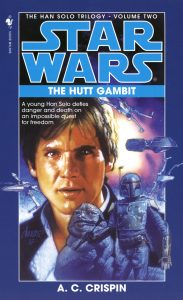A.C. Crispin’s “The Hutt Gambit” (1997), the second book in the “Han Solo Trilogy,” does the best job of tying together disparate aspects of the Expanded Universe of any “Star Wars” work before or since. The author obviously did her research, and she delivers a story so central to the backstory of Han Solo that it’s remarkable it wasn’t told until 20 years after the character made his debut.
In a somewhat odd choice (that I think was mandated by Crispin’s editors), the story starts with Han having already been kicked out of the Imperial Navy, which he had joined at the end of “The Paradise Snare.” He reflects on the action that got him discharged — the rescue of a certain Wookiee from Imperial slavery. Considering how evil the Empire is — later in this book, it plans to wipe out the entire populace of Nar Shaddaa, and we know what it’ll do to Alderaan — it’s remarkable that Han isn’t executed. (By the way, a more detailed account of Han’s rescue of Chewbacca is chronicled by Darko Macan in the comic book issue “Chewbacca” No. 2 in 2000.)
Most of the characters from Han’s days as a Nar Shaddaa-based smuggler come from the 1991 “Dark Empire” comic series, which is set after “Return of the Jedi.” Among this rogue’s gallery are Mako Spince, Roa, Shug Ninx and Salla Zend. Crispin also digs up Rik Duel from the Marvel Comics and Lando’s copilot Vuffi Raa from “The Lando Calrissian Adventures.” She also is the first author to draw upon the Special Edition of “A New Hope” — here, Hutts slither around and Jabba calls Han “my boy.” The crime lord and the ace pilot actually have a good rapport here.
In chronicling the best days of Han’s life, Crispin doesn’t go as deep as she could’ve in developing Han’s friendships with these characters, and she goes a bit to heavy on exclamation points. One highlight is when Han and Lando team up to outsmart Boba Fett, but overall, things come a bit too easy for Han at this point in his life. On the other hand, I suppose he deserves it after the events of “The Paradise Snare,” where he got his heart stomped on by his first love, Bria Tharen (who becomes a member of the Rebellion in this book).
Speaking of romance, Crispin pulls the character of Xaverri out of Vonda N. McIntyre’s much-maligned “The Crystal Star” (1994) and chronicles her whirlwind fling with Solo. But what’s really interesting (and in some ways, inexplicable) is that her skill as an illusionist comes in handy in the Battle of Nar Shaddaa. Whereas some characters use Jedi battle meditation, and some use Sith illusions and some use other forms of magic (like the Nightsisters in “The Clone Wars”), Xaverri uses practical, non-supernatural illusions.
I found the build-up to the Battle of Nar Shaddaa to be filled with too many of the worst kinds of “Star Wars” scenes: A bunch of people in a briefing room talking about strategy (just as with TV, even great writers can be made to look silly when they put too many characters in one scene). And I wondered how Crispin would avoid making the actual battle redundant, but she pulls it off. In fact, the telling of this battle is actually a smooth read as Crispin peppers in great little anecdotes of terror, bravery, and even humor. A highlight is when an overzealous Chewie accidentally rips the entire firing console out of his gunner’s cockpit.
Crispin shows a good grasp of galactic politics here: The Empire is willing to kill millions of innocents on the Smuggler’s Moon in order to make a point that it won’t allow an untaxed black market of goods. We’re told this is standard operating procedure for the Empire. But how can it get away with such a thing without massive rebellions springing up all over the place? I think the answer is a variation of NIMBY (Not In My Backyard); in this application of the phrase, if one’s own planet isn’t being persecuted by the Empire, one doesn’t give it much thought.
The Empire’s attack on Nar Shaadda is a pivotal moment in Han’s view of the Empire just as the destruction of Alderaan solidifies Leia’s views. Further complicating matters, though, is that everyone’s personal threshold for outrage against a tyrannical government is different: Han is the type that doesn’t want to get involved in a rebellion, whereas Leia is the type who tends toward rebelling. In both cases, this can be explained by their upbringing: Leia was raised by an original rebel, Bail Organa, whereas for Han, persecution (under his cruel boss Garris Shrike) was a way of life; he learned to keep his head down and stick to the fringes as a matter of survival. (Ironically, by discharging Han and blacklisting him from legal piloting jobs, the Empire forced Han onto the black market. But, of course, statism isn’t concerned with real outcomes, it’s concerned with state power.)
Through Han, Crispin inadvertently foreshadows a central character trait of Anakin Skywalker, who would get his backstory starting with 1999’s “Episode I.” Anakin grew up as a slave and often said that he hated slavery (although it wasn’t until Season 4 of “The Clone Wars” that the film/TV exploration of the prequel era delved into this trait). Han hates slavery — something we first learned in Brian Daley’s “Han Solo’s Revenge,” where Han balks at smuggling slaves — because he grew up under the thumb of Shrike. But, unlike with Anakin, Han’s anti-slavery stance is front-and-center in his moral code, leading to his rescue of Chewbacca.
Further enhancing this trilogy’s status as the essentially Han Solo backstory, “The Hutt Gambit” includes Han’s first introduction to the Millennium Falcon, and his first time flying it, as he teaches inexperienced pilot Lando. He’ll actually win the ship from Lando in the concluding entry of the trilogy, “Rebel Dawn”; for now, Vuffi Raa is the pilot since the action of the Lando trilogy dodges and weaves with the events here.
“The Hutt Gambit” is a remarkable achievement in research — Crispin not only read the relevant “Star Wars” works out there, but she also figured out exactly where they took place on the timeline. Yet it’s so much better than a dry piece of history. Yes, it sometimes moves a little too quickly and easily through the action, and there are other minor flaws (Xaverri’s trickery is a little too amazing to be practical). But those are nitpicks; this is the book where Han’s famous life — Chewbacca, the Falcon, smuggling — really kicks into gear. If one were to make a list of essential “Star Wars” books to store in a vault for posterity like the American Film Institute does with movies, this would have to be one of the first entries.


